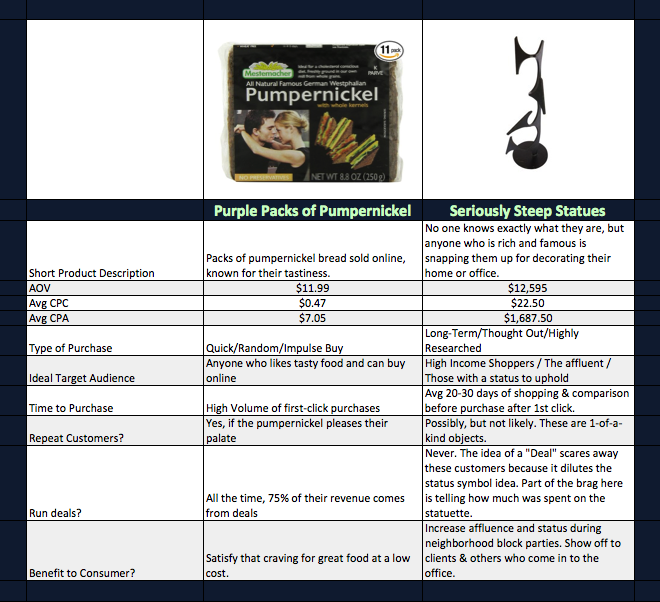If the title of this blog post caused the bile to rise in your throat, than this post is for you.
On the other hand, if you do your best to put one of those “alerts” in every text ad you ever run, then this post is even MORE for you.
Being a PPC expert, you undoubtedly realize that different people respond to different text and call to actions and you’ve probably even run a diagnosis on understanding your target audience. However, I’ve found that audience motive and target audience can differ.
Illustration
Let’s say you work at an agency and have 2 ecom clients, 1 selling purple packs of Pumpernickel, and the other selling Seriously Steep Status Statuettes (odd-looking but incredibly pricey statues for the home and office – you have no idea what these statues are or what they symbolize, but you know people are dropping heavy cash on them right now as a status symbol).
Let’s break down these two sites a little more.
As you can see, these are two highly different products, with highly different target audiences. Don’t get hung up on the “target audience” though, because even target audiences are made of “people” and all people generally share a common interest, to get a good deal.
The importance in these examples (and possibly in your clients) is not the difference in “target audience”, it is the difference in “audience motive.”
THIS DISTINCTION IS IMPORTANT
Check out those CPCs and CPAs in the illustration above for the statuette. Think you want your average Tom, Dick, Harry, Jenny, or Gina clicking on that hoping to find a $50 decoration for the family room? Likewise, think you’ll get those people interested in showing off to their friends to click on your ads for a $13K statue that says “Best Deal on the Web, Get It Cheap!” ? Maybe, but I wouldn’t bet on it (or at least would test heavily).
I’m not saying, “never use ‘deal’ text in ads geared toward a high-income demographic. I’m saying be aware of your audience motive and consider avoiding ‘deal’ language if your audience motive doesn’t support it. Oftentimes, a product will target a specific audience motive, even if it is not a high-priced product.
Here are my suggestions for highlighting eCommerce text for both the “cheap” and the “high-priced, valuable product” non-brand campaigns. 
Notice, in some ways, people can fall into both categories. For example, I love deals, I love saving money but when it comes to things I HAVE to have work, I’m more interested in the quality (e.g., I will buy Mac over PC, Honda over Chevy – yes, that is our van in the picture. Yes we are pathetic, but darn it if it’s not kind of cute).
So, the question is, how do you create ads that emphasize the benefits to your customer motives for your specific client offerings?
Money-Saving or Deals Motives
Here are some ad text ideas for those products geared towards the money-savers among us. They tend to love seeing those deal CTAs.
- Cheap
- Price Match Guarantee
- We Beat Prices
- We’ll Beat Any Price by 2%
- We Match Any Verified Price!
- We Match Any Price!
- Free {Add-On Item} (For instance, if it’s a refrigerator, maybe it will come with a free filter).
- Free Setup
- Free Shipping
- Deal
- Hurry
- Sale Ends Soon/Tomorrow/Friday
- Sale Ends {Use Countdown Ad Customizer}
- Only a Few Left
- In Stock
- Bargain
- Clearance
- Closeout
- Discount
- Liquidation
- Overstock
I like to try different variations of these and found that these tend to go with the user motive to save money and/or instant gratification (I want it shipped free, and now!).
I will say this important caveat when targeting the “deal-focused” audience motive. Be honest.
It is tempting to want to use the most intense call to actions always. However, as with any dishonest tactic, the initial increase in traffic/sales is hurt by the long-term impact of losing customer trust. If your sale is not 25% off, then don’t say it is. Don’t be the boy who cried wolf. I’ve seen it with one client specifically who does an amazing job with email sales. They’re not sending daily/weekly emails about this random tiny percentage off or that one, pretending the world is on fire unless the customer takes advantage of a deal. They put out solid sales and their customers follow those email campaigns insanely closely and convert like crazy when they do hit. They trust this company when the company says “sale”.
Status or Quality Motives
Here are some ad ideas for those products geared towards the status or quality minded among us. These terms tend to be geared more towards the customer who wants that product that will measure up to their high standards. As an example, perhaps these are phrases/words you would put in an ad to someone looking at a Lexus or a Mac.
- Unique
- One-of-a-Kind
- Hand-Crafted (Signifies care and quality which suggests uniqueness)
- Crafted with Care
- Custom-Made
- Specially Made
- Worth (sell what a product is worth, not how much it costs)
- Retains Worth (Products with high resell value often demonstrate quality)
- Valuable
- Invaluable
- High Standards (show how your standards in making the product are as high as your customers’)
- Premium
- Official
- Authentic
- Trademark Symbols in Brand ® ™ (For Mac, hold option: ®hold option and r, and ™hold option and 2. For PC: NumPad must be on: ®hold alt and 0174, and ™hold alt and 0153).
- Long-Lasting
- Warranty(“Comes With 12 Yr Warranty. Yeah, We Trust It That Much”)
- Simplify Your Life (this product is so great, it will make your life easier)
Avoid these negative “Status” terms. There’s a fine line between enjoying quality and arrogance. Walk it carefully in your ads!
- Exorbitant
- Lavish
- Overpriced
- Plush
- Posh
- Swanky
- Steep
- Extravagant
Hopefully some of these spark ideas in your mind for creating ads targeted not simply to your audience, but to your audience motive!
What About Brand Ads?
As a final concession, please note that I do think different tactics should be experimented with for brand campaigns. Often times, someone who already understands a certain brand’s value can actually want to be finding a deal on that product. She understands the value, but is hoping to save a buck. Okay, experiment with some of the ‘deal’ terms here, but even then monitor closely.
What about you? Have you experienced this, or the opposite with your campaigns? Any other ad text suggestions you would offer to help us out?
BTW, this is free but any article written on ad text should include a link to this well-done infographic on ad testing by Avalaunche Media on Search Engine Land: Infographic: 26 Ideas for Split Testing Your Search Ads. Check it out and learn!




